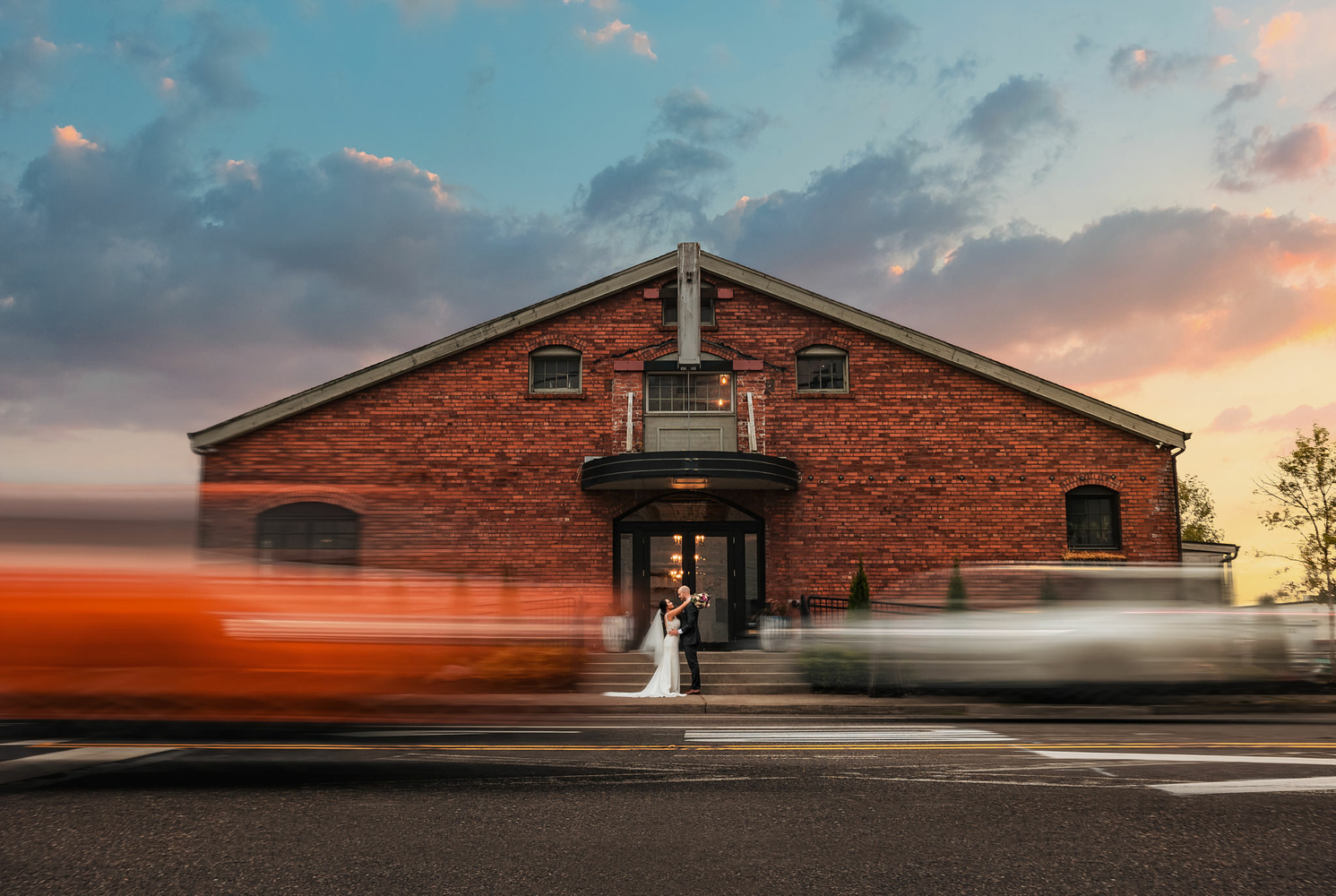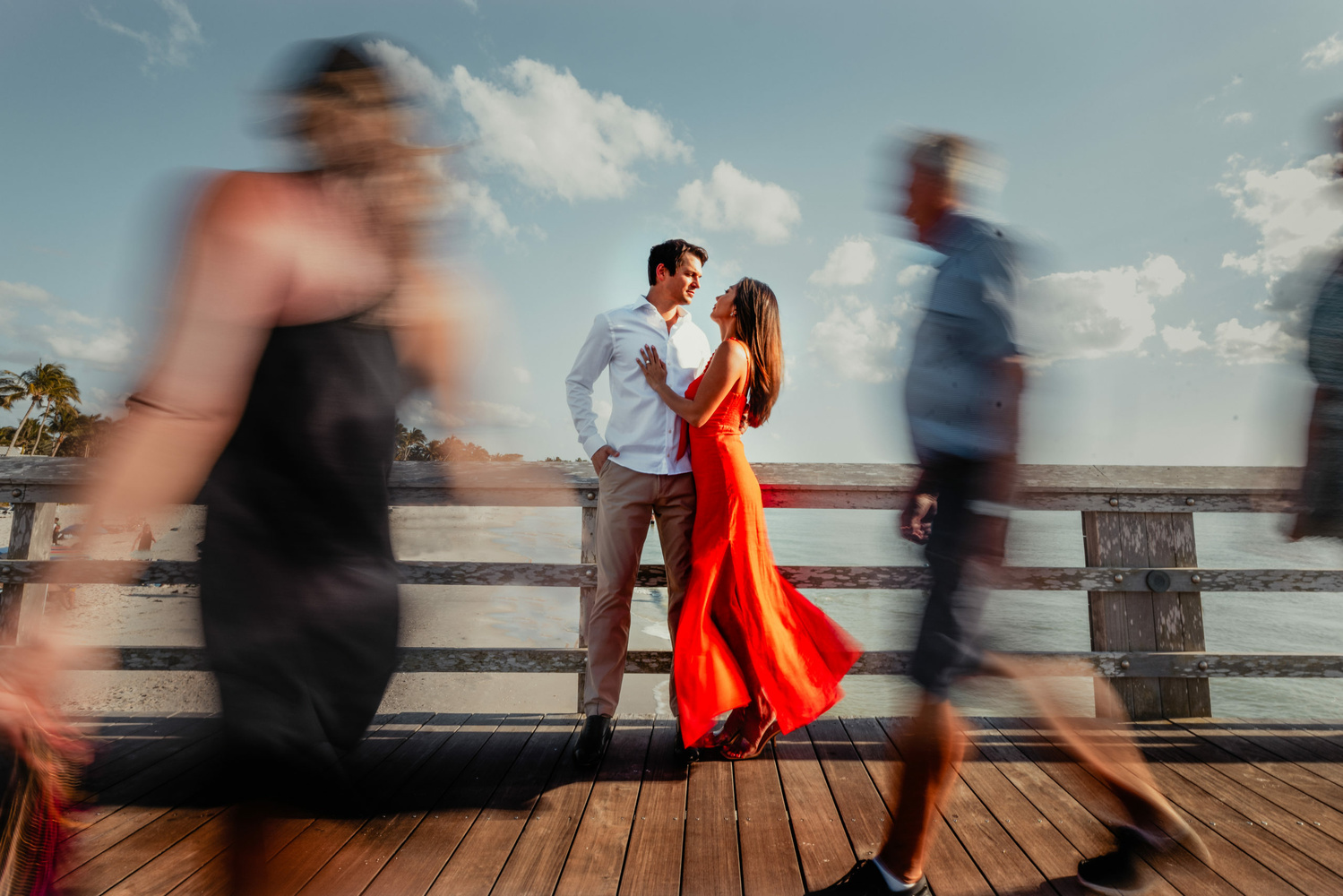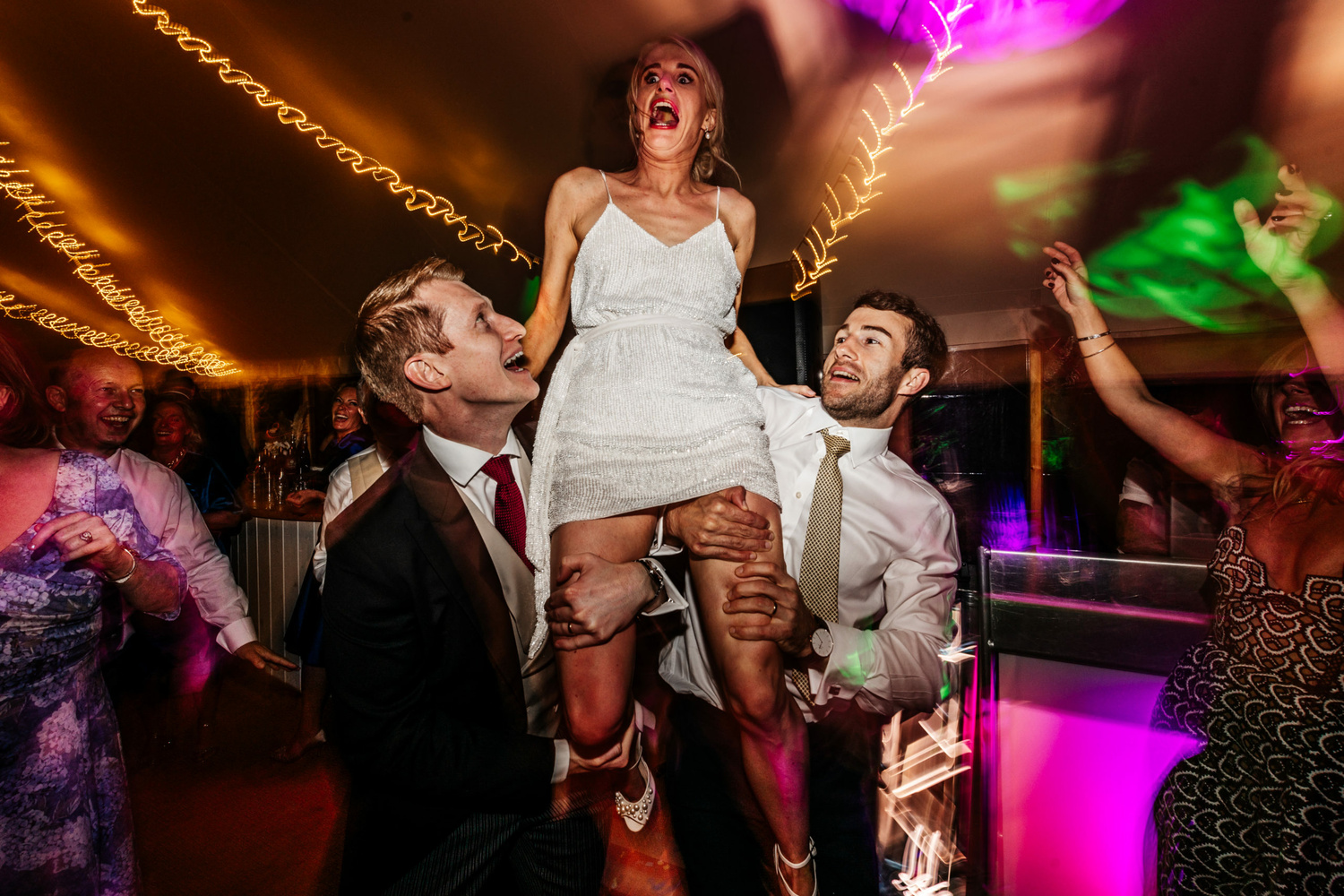Some of my favorite creative photography techniques to use are those that allow us to capture moments in ways we could never see using just our eyes. One technique, in particular, that I turn to for capturing unique portraits involves using long exposure, aka shutter drag. Long exposure portraits open up a number of creative possibilities and often result in “wow” moments with my clients. Putting the technique to use does require some skill and preparation, but it’s easy enough to master once you know the basics.
Here is a list of the creative ideas for long exposure portraits that we’ll cover below:
- Understand the Basics
- Use Traffic and Cars
- Stand Out in Crowds
- Create Dynamic Waves
- Capture Motion on the Dance Floor
- Use a Moving Wedding Party
- Get Creative With Other Moving Objects
Let’s get started.
The images in this article were provided (with permission) by the photographers at Wedding Maps, a directory of the world’s best wedding photographers and wedding venues.
Understand the Basics
The first step to creating impactful long exposure portraits is understanding the basics of shutter speed and motion blur.
Shutter Speed for Motion Blur: To jog your memory, the longer the duration of the shutter speed, the more motion blur you’ll capture from the moving objects in the photograph. In addition, the faster objects will show more blur than the slower objects at the same shutter speed. As an example, if a car is moving fast through the scene, a shutter speed of 1/30th might capture some of the motion of the car. But if the car is moving slowly, you might need a shutter speed of a full second or slower to capture the desired motion “look.” Of course, the amount of motion you want to capture depends on the style and vision for the photograph.
Camera Shake: The second concept to understand for long exposure portraits is the concept of camera shake. Camera shake is a common problem that occurs when the camera is not held still during the exposure. So, essentially, the entire photograph is blurry instead of isolating the blur to the moving object only. There are several techniques that can be used to avoid or reduce camera shake, such as using a tripod, setting a slightly faster shutter speed, or using flash to freeze the subjects.
Using Flash to Freeze Motion: The third concept to understand is that flash can freeze motion on the subjects or objects that the flash is hitting. So, for example, photographers can intentionally move the camera and create intentional camera shake while freezing the subject with flash. We’ll review this technique later in this article.
Ideas for Long Exposure Portraits
Now that we understand the basics of long exposure portraits, here are six creative ideas for using this technique.
1. Capture the Motion in Traffic and Cars
 Photo by Holding and Co (Website | Wedding Maps Profile)
Photo by Holding and Co (Website | Wedding Maps Profile)
Few creative night photography techniques can compete with the look of capturing the motion of traffic in the frame with your subjects. While you can photograph the motion of passing cars during the day, this technique works especially well during the evening. The reason for this is that moving cars create amazing light trails when shooting long exposure portraits at night.
Tips for Capturing Long Exposure Portraits With Traffic
- Remind your subject(s) to hold very still
- Larger vehicles, such as buses, take up more space in the frame and can therefore be more impactful than smaller vehicles.
- Vehicles moving around windy roads can be more visually interesting than vehicles going in a straight line.
- If you are having trouble getting enough traffic to go through the scene, consider doing a composite photo, capturing a plate shot of your couple with no cars in the frame and then taking several more shots with cars passing through the frame. Then, you can stack the photos in post and mask out any streaks of light that pass directly in front of your subjects. You can learn more about shooting and editing composite portraits in this beginner’s guide.
How to Use Flash to Freeze Your subjects
Gear-wise, a single speedlight with a softbox should provide enough power to properly light your subjects when shooting at night. One general rule that you can refer to when you start dialing in your flash power is to use the inverse of your ISO. For example, if your ISO is set to 1,600, you can set your flash power to 1/16th. Of course, other factors like aperture, the distance between your flash and your subjects, as well as your shutter speed will impact the outcome, but you can start here and make any necessary adjustments.
Other Examples
 Photo by Jessie and Dallin (Website | Wedding Maps Profile)
Photo by Jessie and Dallin (Website | Wedding Maps Profile)
 Photo by Loc Le (Website | Wedding Maps Profile)
Photo by Loc Le (Website | Wedding Maps Profile)
2. Capture the Motion in Crowds
 Photo by Gus Trujillo (Website | Wedding Maps Profile)
Photo by Gus Trujillo (Website | Wedding Maps Profile)
People in motion also make for great long exposure props to draw attention to your subject(s). This technique is perfect for crowded public areas such as landmarks or tourist attractions. Rather than battle the crowds, work with them, and use them in your compositions.
In my experience, closer to dusk tends to work best for long exposure portraits (or dawn for early birds). If you can capture your shot around sunset or just after, even better. At this time of day, you can use natural light and dial in an appropriate shutter speed, typically between ¼ to ½ second. If it’s still too bright out, you’ll need to use an ND filter (3-4 stops) or else close down the aperture.
Place your camera on a tripod and compose your shot. Depending on how much room you have to move, you can use a wide angle or telephoto lens to capture these long exposure portraits. Just use a wide enough frame to give the shot context and allow enough space for people to move. Be mindful of people walking by when placing your tripod, and capture multiple shots to create a composite if people are walking in front of your subjects.
More Examples of Long Exposure Crowds
 Photo by Andreas Pollok (Website | Wedding Maps Profile)
Photo by Andreas Pollok (Website | Wedding Maps Profile)
 Photo by Lin and Jirsa (Website | Wedding Maps Profile)
Photo by Lin and Jirsa (Website | Wedding Maps Profile)
 Photo by Kristin Cheatwood (Website | Wedding Maps Profile)
Photo by Kristin Cheatwood (Website | Wedding Maps Profile)
3. Capture the Motion in Waves and Water
 Photo by Chad Winstead (Website | Wedding Maps Profile)
Photo by Chad Winstead (Website | Wedding Maps Profile)
The motion in the ocean makes an excellent backdrop for long exposure portraits. For these types of portraits in this setting, use wide angle lenses (15-35mm) to exaggerate the motion in the photo. Because wide angle lenses tend to feature more lens distortion around the edges, place subjects in the center of the frame to minimize the effects of lens distortion on my subjects. Speaking of subject placement, with such a pronounced horizon, you should place your subjects’ heads below or well over the horizon. Avoid placing their heads on the horizon line.
How Smooth or Silky Should the Waves Be?

The slower your shutter speed, the smoother or silkier the waves will be. You can quickly go from a little bit smooth to outright glassy in just a few seconds (of shutter speed). For long exposure portraits in front of waves, opt for a shutter speed of ¼ to ½ of a second. A faster shutter speed will probably not capture enough motion, and too slow of a shutter speed will capture more motion than you need. Of course, that’s up to your preferences. Also, like I mentioned previously, if it’s too bright out, you’ll need to use an ND filter or otherwise stop down your aperture.
Double check your shots before walking away to ensure your subjects are tack sharp. Your tripod was likely in the sand, and there’s a good chance that the wind is blowing. Either of these factors could cause camera shake (not the one you want) if the camera shifted at all during the shot.
More Examples of Long Exposure Portraits in Water
 Photo by Rey Benasfre (Website | Wedding Maps Profile)
Photo by Rey Benasfre (Website | Wedding Maps Profile)
 Photo by Mauricio Urena (Website | Wedding Maps Profile)
Photo by Mauricio Urena (Website | Wedding Maps Profile)
4. Capture the Motion of a Wedding Party
 Photo by Jay Cassario (Website | Wedding Maps Profile)
Photo by Jay Cassario (Website | Wedding Maps Profile)
Weddings afford us many opportunities to flex our creativity. One thing you usually have a lot of at weddings is people. Let’s use them for creative long exposure portraits! Incorporate VIPs, like the wedding party, when using this technique at weddings. For the most part, follow the same basic guidelines for capturing motion in crowds. The advantage here is that you have more control over the people passing through your shot. This means you can direct their movement to more easily time the shot and get it done in a single frame.
More Examples of Long Exposure Wedding Party Photos
 Photo by 1836 Photographie (Website | Wedding Maps Profile)
Photo by 1836 Photographie (Website | Wedding Maps Profile)
5. Capture Motion on the Dance Floor
 Photo by Kivus and Camera (Website | Wedding Maps Profile)
Photo by Kivus and Camera (Website | Wedding Maps Profile)
Dance floor portraits give us an opportunity to really get in the action and make the viewer feel like they were there. Adding motion to dance floor photos also allows us to better capture the excitement and energy of the moment. Jason Vinson goes into detail on how to use this technique here, but here’s a basic overview of what you need to do to make it happen.
The Necessary Tools for This Technique
As far as lighting goes, we’ll usually add an on-camera flash, which we’ll point towards our subjects. You’ll notice in the image above that an off-camera flash was used, but if you’re shooting solo or don’t have a light stand handy, go with an on-camera flash.
 Photo by M and G Photography (Website | Wedding Maps Profile)
Photo by M and G Photography (Website | Wedding Maps Profile)
Dance Floor Motion Blur Steps
First, dial in the settings on your camera and flash. Here are some go-to settings to get started:
- Camera: 1/5th, f/4.0, ISO 100 (starting)
- 1/8th flash power, 70mm zoom (starting)
Next, adjust the zoom on your flash to be wider than your focal length (Jason opts for a 70mm zoom on a 35mm focal length). Once the zoom is set, choose front or rear curtain sync. Using front curtain sync will allow you to immediately capture the moment and then create light streaks with panning or zooming motion for the duration of the shutter being open. A rear curtain sync, however, will fire the flash at the end of the shot.
Lastly, create motion using one of the following methods:
- Twist (rolling the camera from left to right or right to left, like turning a steering wheel)
- Zoom (zooming from one focal length to another - works with zoom lenses only, obviously)
- Shake (moving the camera up and down)
- Pan (swinging the camera from left to right or vice versa, like panning a camera on top of a tripod)
It’s important to ensure that the lighting you intend to use to create streaks is behind the subjects on the dance floor. This will help keep the often colorful lights from falling on your subject.
6. Get Creative With Other Moving Objects and Concepts
Like car lights, waves, and people, we can also use other moving objects to capture motion in long exposure portraits. Some examples might include water fountains, raindrops, sparklers, or other light sources or objects that make sense within the context of the shot. The important thing is to plan with intention or anticipate moments and then create a unique photo.
 Photo by Angie Nelson (Website | Wedding Maps Profile)
Photo by Angie Nelson (Website | Wedding Maps Profile)
 Photo by Jeff Tisman (Website | Wedding Maps Profile)
Photo by Jeff Tisman (Website | Wedding Maps Profile)
 Photo by Courtland Photography (Website | Wedding Maps Profile)
Photo by Courtland Photography (Website | Wedding Maps Profile)
 Photo by Bernadeta Kupiec (Website | Wedding Maps Profile)
Photo by Bernadeta Kupiec (Website | Wedding Maps Profile)
 Photo by SMJ Photography (Website | Wedding Maps Profile)
Photo by SMJ Photography (Website | Wedding Maps Profile)
Conclusion
I hope that you found these six creative ideas for long exposure portraits helpful. These represent just a handful of ways you can use this creative photography technique. Be sure to practice the technique before attempting it during a paid shoot. Once you have it down, it’ll add a powerful tool to your repertoire, which you can then use to wow your current clients and throw in your portfolio to bring in new ones. If you're interested in joining a directory of incredible photographers, please check out Wedding Maps.







I didn't realize you were a FStoppers writer. I loved this article!
I think he's one of the OG writers. :)
He's a photo G for sure!
Michelle VanTine and Deleted User ... I'm OLD for sure ... haha. I've always loved and supported this site. Lee and Patrick are awesome guys (as well as the entire team). Thanks for checking out the article.